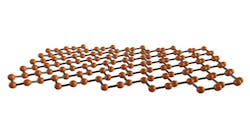Most of us have heard about graphene. First produced in 2003, it is a single layer of graphite atoms in a lattice and is 100 times stronger than steel and is an efficient heat and electric conductor. As it turns out, there are other atoms that also have some interesting properties when arranged in a single layer.
Researchers at the University of Texas (UT) at Austin’s Cockrell School of Engineering have created silicene (see the figure), a one-atom-thick layer of silicon. It has a hexagonal honeycomb structure. Silicene, like graphene, has been known but turning theory into actual material was a challenge that has now been overcome, at least on a small scale. Previously, very high temperatures were required to make small amounts of silicene.
UT’s Deji Akinwande teamed with Alessandro Molle at the Institute for Microelectronics and Microsystems in Agrate Brianza, Italy, and used a new method that initially limits the material’s exposure to air. The process starts with a block of crystalline silver in a vacuum chamber. Silicon is evaporated and condensed on the block. Next, a nanometer-thick layer of alumina is added. This allows a film of the layers of silver, silicone, and alumina to be removed by peeling them off the block. Silicene has also been grown on ZrB2 and iridium.
This film was transferred to an oxidized-silicon substrate for testing. Some of the silver was carefully removed so there were two silver electrodes on either side of the silicene sheet. This was done under vacuum conditions. The transistor was then tested. Subsequent tests in open-air conditions will follow.
The characteristics of silicene are still under investigation. Silicene can be used with different dopants to change the material and do things like tune the band gap of the material as is done with bulk silicon. In theory, it could be used to construct faster and more power-efficient transistors.
References:
One-Atom-Thin Silicon Transistors Hold Promise for Super-Fast Computing
